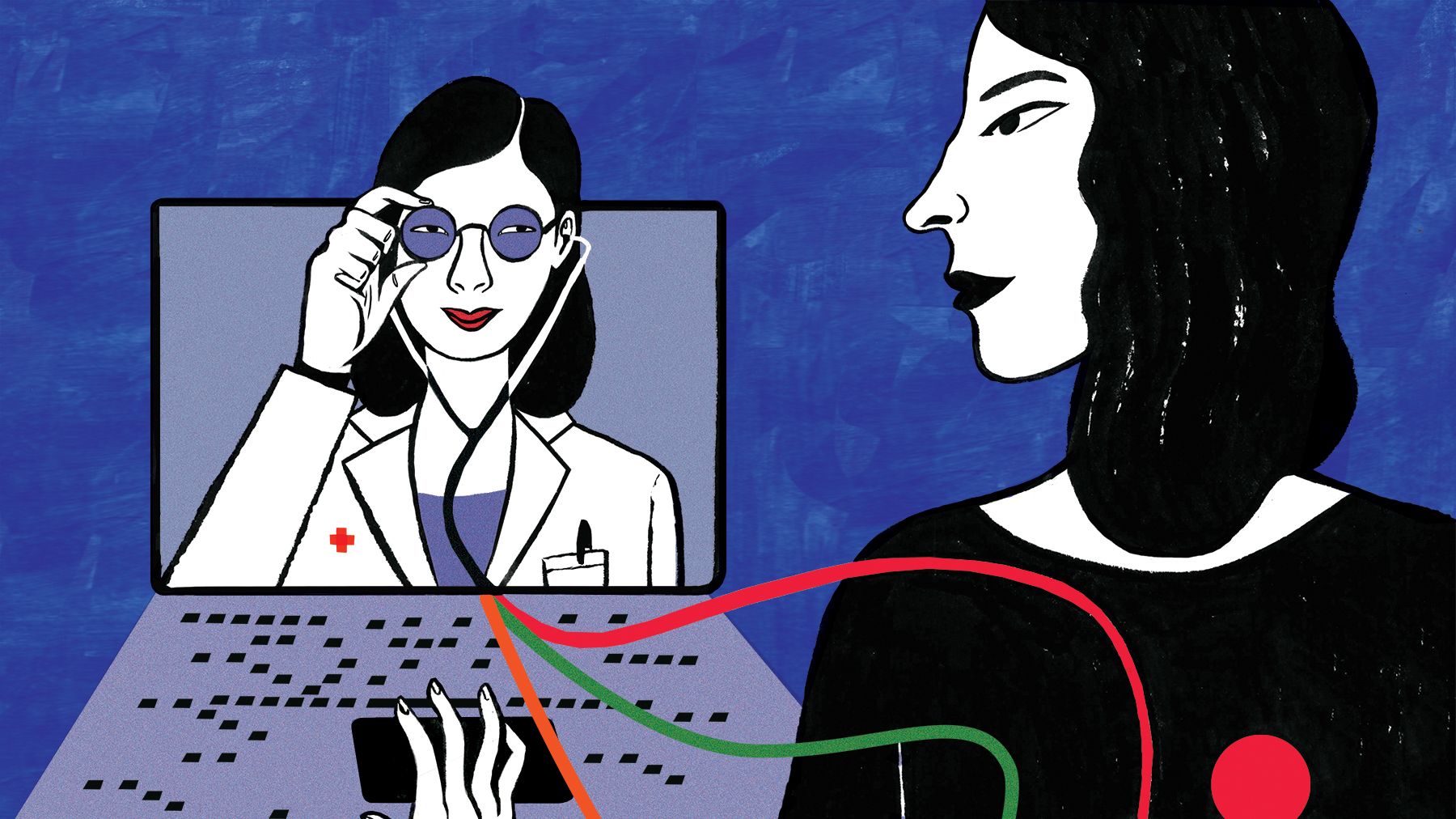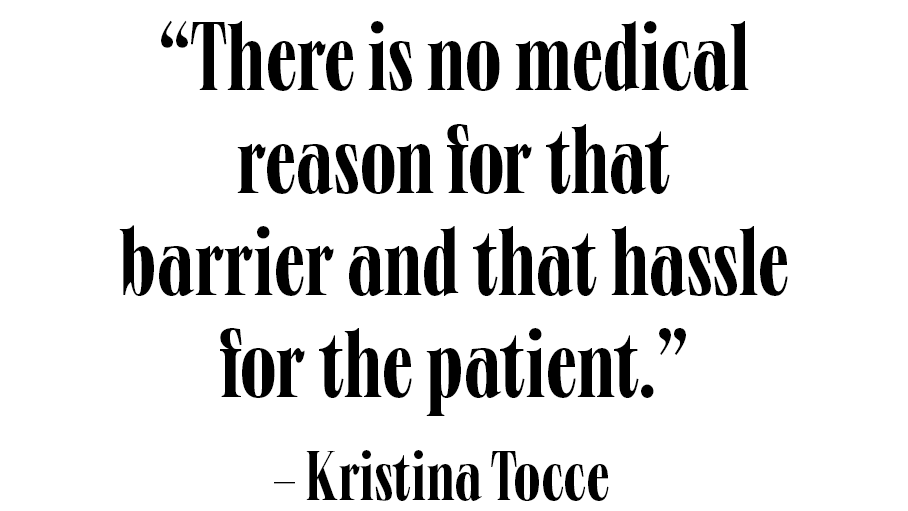A Bitter Pill
The pandemic made telemedicine mainstream. Now, a skin check or a cold prescription is just a video call away. But when it comes to abortion, just because it’s \201cvirtual\201d doesn’t mean it’s any easier.

In April, Kristina Tocce was video chatting with a woman who wanted to end her pregnancy. Tocce, an obstetrician-gynecologist, was used to providing this kind of care; she’d been virtually prescribing abortion pills from her Colorado office to patients there and in New Mexico for more than a year. A virtual procedure means women don’t have to travel to an abortion clinic to get care, which is convenient in normal times and potentially lifesaving when a deadly respiratory virus is surging.
But this patient wasn’t sitting on her couch or at her kitchen table. This patient had just crossed the Texas–New Mexico border and was alone, parked in her car. She had driven four hours from her home in Texas for the consult, the required first step to receive an abortion. After the appointment, she turned right back around; she hadn’t been able to find overnight childcare, so staying in a hotel wasn’t an option. She would make the same trip again the next day to retrieve the package of abortion pills the clinic had mailed to her friend’s New Mexico address. Legally, she had to receive them in the state even though she wouldn’t set foot inside a doctor’s office.
Weeks earlier, Texas had deemed abortion nonessential health care under the guise of preserving PPE and hospital beds. While a virtual appointment wouldn’t require these resources, telehealth abortion (a.k.a. teleabortion) is banned in Texas, pandemic or not. To even video chat with a provider who could help her, the patient had to physically be in one of the 30 states where this service is legal. In total, she drove 16 hours over two days simply to access a constitutionally protected procedure.
Tocce, vice president and medical director of Planned Parenthood of the Rocky Mountains, was stunned. She recalls another Texas patient who made a 10-hour trip with a disabled family member and their health aide; the trio had stayed in a hotel until a package of pills arrived in the mail the next day. “It’s really frustrating as a provider to see patients have to go through that,” says Tocce. “There is no medical reason for that barrier and that hassle for the patient.”
Telemedicine has transformed the way Americans receive medical care during the pandemic, and the model will no doubt continue to grow even after COVID-19 vaccines are widely distributed—one analysis suggests sevenfold by 2025. But as medical care continues to shift online, people seeking abortions could be left behind.

In 2017 (the most recent year with data available), nearly 40 percent of all abortions in the U.S. were done via pills. Patients take two: mifepristone, which blocks the hormone progesterone, preventing the pregnancy from progressing; then misoprostol, which induces cramping and bleeding to empty the uterus. The regimen is FDA-approved up to 10 weeks into pregnancy and legal in all 50 states, but 20 states, including Texas, ban prescribing abortion drugs through a phone or video appointment. The first pill, mifepristone, is also subject to a Risk Evaluation and Mitigation Strategy (REMS), an FDA drug-safety program. Under normal circumstances, this means that mifepristone can be dispensed only in clinics, medical offices, and hospitals by or under the supervision of a certified health-care provider, and doctors have to stock the drug in their office or clinic; neither brick-and-mortar nor mail-order pharmacies can carry it. Though the FDA guidelines are unclear, most doctors interpret the language to mean they must give pills to patients in their clinic, forcing them to act as both physicians and pharmacists, says Kirsten Moore, director of the Expanding Medication Abortion Access (EMAA) Project.
Prior to the pandemic, abortion providers generally did not mail pills to patients unless they were a part of the small FDA-authorized research study in which Tocce’s clinic participates. (The TelAbortion project operated in 14 states and Washington, D.C., in 2020. Elizabeth Raymond, a senior medical associate at Gynuity Health Projects, which runs the TelAbortion project, says participating clinics had mailed just over 1,500 packages of pills as of December 2020.) In desperation, some women turned to the deep corners of the Internet, including a legally murky telemedicine site founded in 2018 by a Dutch doctor who ships pills to the U.S.
Get exclusive access to fashion and beauty trends, hot-off-the-press celebrity news, and more.
But as telemedicine abortion proved indisputably safer than in-clinic care during the pandemic, the American College of Obstetricians and Gynecologists (ACOG)—which had called for the REMS to be overturned in 2018—filed suit (along with reproductive justice group SisterSong Women of Color Reproductive Justice Collective) in federal court in May 2020 for providers to be able to mail the drugs for the duration of the crisis, citing the regimen’s extensive safety record. (Evidence shows the process is effective in 95 percent of abortions and that serious complications occur in fewer than 0.4 percent of patients.) The lawsuit, brought by the American Civil Liberties Union (ACLU), notes that, of the 20,000 drugs the FDA regulates, mifepristone is the only one that must be dispensed in a medical office but can be taken at home with no clinical supervision.

“The whole reason for the REMS is a political way to restrict access to the pills,” says Elisa Wells, the cofounder and codirector of Plan C, a site that provides information on medication abortion. “And [politicians, lobbyists, and regulators] have been successful because providers don’t want to jump through all those hoops in order to provide the care.” There’s no medical reason to block mailing the pills, adds Daniel Grossman, a professor of obstetrics and gynecology whose 2017 study on a pilot program in Iowa found that the telemedicine model is just as safe as providing abortion care in person. (Fun fact: Mifepristone is actually much safer than Viagra. Viagra, however, is not subject to REMS—no surprise there.)
On July 13, 2020, a federal court in Maryland ruled that the FDA must allow providers to mail mifepristone during the pandemic—but they would still have to adhere to state laws. The Trump administration appealed to the Supreme Court, and on January 12, 2021, in the first abortion decision with Amy Coney Barrett on the bench, SCOTUS reversed the lower court’s ruling, reinstating the FDA’s restriction on mailing. In the time between the two rulings, a number of U.S. doctors had opened virtual services; it is unclear if they can continue operating in the same way without action from the Biden administration. But as Wells put it: “The genie’s out of the bottle. And once the genie is out of the bottle, it’s really hard to get it back in.”
One of the biggest benefits of receiving abortion pills in the mail is not having to travel to a clinic—possibly twice if your state has a mandated waiting period after “informed consent” counseling. Five hostile states have just one abortion clinic within their borders. The majority of people seeking abortions are living on low incomes, and travel and childcare can be costly. Teleabortion offers flexibility; Tocce is able to see patients outside traditional clinic hours if that’s better for the patient’s work or childcare schedule. She’s even treated patients who couldn’t visit a clinic because they were quarantining for COVID-19 and, if forced to wait for an in-person appointment, would have been too far along in their pregnancy to use pills. New asynchronous models (like texting services and an AI chatbot program that Planned Parenthood is piloting) also streamline the unnecessarily arduous process.
Telemedicine is also helpful for people who are largely homebound, including some people using wheelchairs and others with chronic illnesses, says Laurie Bertram Roberts, executive director of the Yellowhammer Fund in Alabama, a state with a ban. It can also be a relief for those who are anxious going to clinics based on past negative medical experiences, such as people who are Black or Indigenous, gender-nonconforming, undocumented, or even overweight, Roberts says.
But just because teleabortion might be easier than getting in-clinic care, that doesn’t mean it’s easy. Between remote schooling and working from home, some families might be battling for Wi-Fi, making it difficult for a pregnant person to video chat with an abortion provider on the same network, says Amy Hagstrom Miller, the president and CEO of Whole Woman’s Health, which runs eight clinics in five states. Whole Woman’s Health has done audio-only consults for people with bandwidth issues and for those who don’t have smartphones. Some patients drive to coffee-shop parking lots or reserve private rooms at their local library to do the consult, either because they can’t speak in their home or because they’re out of data for the month, says Melissa Grant, the chief operating officer of Carafem, a network of reproductive-health clinics that has participated in Gynuity’s TelAbortion project since 2018.

For some patients—like those with abusive partners, religious family members, or controlling parents—it wouldn’t be safe to talk about getting an abortion on a video call at home. Telemedicine providers are devising solutions, including informing people that they can do the consult in their car and that, for some, pill packages can be shipped to any address in the state; Carafem has even sent pills to a FedEx customer center. During consults with Just the Pill, a Minnesota service that launched in October 2020, clinicians ask patients if they feel safe at home, then devise a care plan if they don’t. In Just the Pill’s first three months, many of its 40 patients did the consults in their cars.
Though communicating from cars might give patients much-needed refuge, it could also create a feeling of isolation. The empathy that abortion necessitates is hard to replicate in a virtual model. “A lot of the stigma surrounding abortion in this country has taught people to believe that they’re the only person they know who’s had an abortion,” says Hagstrom Miller. She hopes to translate the compassion Whole Woman’s Health provides to in-person patients to those taking abortion pills at home to “be sure that we don’t slide backwards into this sort of secret abortion that you’re hiding.” To help humanize the experience, Carafem is shipping abortion pills with care-package items, like a maxi pad, antinausea medications, a single-use heating pad, and herbal tea. “Those kinds of little differences can make the experience just a little bit easier,” Grant says.
Real change will depend partly on the Biden-Harris administration directing federal agencies to reevaluate current restrictions. Advocates hope that, on day one, Biden will instruct the FDA to allow providers to mail pills for the duration of the pandemic and, within the first 90 days of taking office, Biden will direct the FDA to review the scientific data and determine the necessity of the mifepristone REMS. Moore believes getting restrictions removed entirely is a heavy political lift; a more viable middle pathway is for the FDA to keep most of the restrictions but permanently allow mailing. Biden has already pledged to reverse the Hyde Amendment, a federal budget rider that bans Medicaid from covering abortion in 34 states and D.C., increasing accessibility overall.
Even if the FDA restrictions change, Moore and others recognize that access issues will still exist. Lifting the REMS would be “really meaningful in states that do not ban telemedicine for abortion. It will not be meaningful for places that do,” says Bertram Roberts. Until states overturn their bans, they could pass other laws eliminating waiting periods, like Virginia did in early 2020. They could also pass laws permitting advanced-practice clinicians like nurse practitioners, nurse midwives, or physician assistants to administer medication abortion, which 32 states currently do not allow. Hagstrom Miller says moves like these would help improve access in Texas, where, thanks to the political climate, there are so few doctors willing to provide an abortion in person that Whole Woman’s Health flies physicians in from Brooklyn, Seattle, and San Francisco.

But the telemedicine boom could upend the business model of abortion clinics in ways good and bad. The average cost of an in-clinic medication abortion is around $535, whereas some new teleservices have offered treatment for much lower: Carafem offers telemedicine abortions for as low as $325. Just the Pill costs $350, though it’s a pay-what-you-can model supported by the Minnesota abortion fund Our Justice. Choix serves California for $199 and Hey Jane is available in New York and Washington state for the same cost. Patients at Choix and Hey Jane can get financial support through Reprocare, a new digital abortion fund that’s integrated into the checkout, according to its founders Morgan Love, a software engineer, and Phoebe Abramowitz, a healthcare organizer. “It’s important that these platforms are financially accessible from the beginning,” Abramowitz says.
These prices are beneficial for many women, but possibly with unintended consequences for traditional clinics. “In theory, a single telemedicine service in a state can serve all the patients in the state,” Raymond says. “If the telemedicine people are skimming off all of the early abortions, then the in-person clinics aren’t going to be able to continue to function.” Hagstrom Miller says that while this problem isn’t specific to abortion—any medical practice needs a certain amount of in-person patients in order to pay for rent, electricity, and staff—“if half of our patients were not in the clinic, the majority of clinics that I manage would not be able to stay open.” That would be harmful to people who need abortions later in pregnancy or prefer an abortion method other than pills. To stay in business, clinics will have to diversify the kinds of health services they offer—better for patients who need more access to trans-affirming health care, HIV PrEP, prenatal care, and midwifery. It’s also good for clinics in the long run, Bertram Roberts says; they need to be financially prepared for the possibility of Supreme Court rulings blocking abortion access in their state completely. She notes that dozens of Texas clinics closed after HB2 went into effect in 2013, and even after the Supreme Court overturned the law in 2016, some never reopened. Buildings had to be sold and providers moved away.

Increased abortion-pill access also requires grassroots activism and political will. Grossman’s ideal future includes getting a mifepristone prescription from your regular doctor and picking it up at a pharmacy or from your mailbox. Eventually, he hopes trained pharmacists will be able to prescribe medication abortion the way they can prescribe birth control in 13 states. Better still, pills would be available over the counter like Plan B, though that could take 10 years or longer.
A future with accessible teleabortion care means that those seeking to terminate their pregnancy can do it with an ounce of peace—away from the sign-wielding protestors who crowd clinic parking lots. Telehealth denies these protestors their most offensive political weapon: harassing women seeking care. “It changes everything,” Bertram Roberts says. “All of their scare tactics don’t work against medication abortion. They can’t stand outside with big, bloody signs, because how are they going to track down everybody’s house? What are they going to do, just find someone’s miscarriage photos? Because that’s all it is.”
A version of this story will appear in the Spring 2021 print issue of Marie Claire.
Illustrations by Carla Indipendente